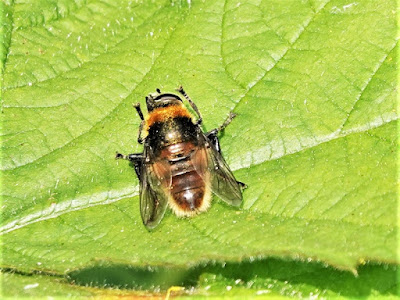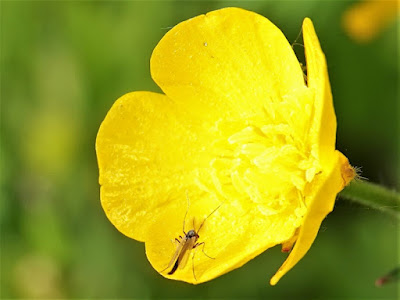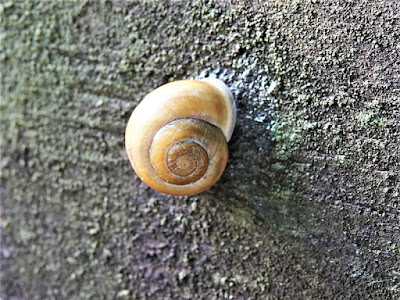12.0°C > 17.0°C: Another day with areas of medium / high cloud. Light easterly breeze. Good visibility in haze.
Sunrise: 05:18 BST
* = a species photographed today
! = a new species for me here this year
!! = a new species for me in Shropshire
Priorslee Balancing Lake: 05:05 – 06:15 // 07:20 – 09:55
(104th visit of the year)
Bird notes:
- a Common Peafowl (Peacock) was again calling from the University grounds at c.05:30
- *the resident Canada Geese still have six goslings.
- *the resident Greylag Geese still have three goslings.
- a Lesser Whitethroats was singing its full song from the Ricoh hedge at the West end at c.09:30. It was sharing its dense thicket with a singing Reed Warbler. It is not too unusual for Reed Warblers to sing from areas away from the reeds when they first arrive.
- a Garden Warbler was singing from the south-west copse c.05:30. It was not seen or heard again.
Counts of birds noted flying over:
- 2 Canada Geese: a pair outbound
- 6 Wood Pigeons
- 1 Jackdaw
Hirundines etc. noted:
- 1 Barn Swallow dropped in for a quick drink and departed
- 1, at least, House Martin heard over the estate area. My view was blocked by trees at the time.
Warblers noted (the figure in brackets relates to birds heard singing):
- 1 (1) Cetti's Warbler
- 13 (13) Chiffchaffs
- 9 (9) Reed Warblers
- 18 (15) Blackcaps
- 1 (1) Garden Warbler
- 1 (1) Lesser Whitethroat
'nominal' warbler:
- 3 (3) Goldcrests
Counts from the lake area:
- *4 + 6 (1 brood) Canada Geese: one additional pair flew in and were chased away
- *2 + 3 (1 brood) Greylag Geese
- 2 Mute Swans
- 3 (3♂) Mallard
- 4 Moorhens
- 24 + 2 (2 broods) Coots
- 4 Great Crested Grebes
Seen on the street lamps poles pre-dawn:
Moths:
- !*1 White Ermine Spilosoma lubricipeda
- !*1 White Ermine Spilosoma lubricipeda
Spiders:
- 1 Stout Sac Spider Clubiona sp.
Noted later:
- 1 Stout Sac Spider Clubiona sp.
Noted later:
Butterflies:
- Green-veined White Pieris napi
- *Speckled Wood Pararge aegeria
- Green-veined White Pieris napi
- *Speckled Wood Pararge aegeria
Moths:
- Plain Gold Micropterix calthella
- Common Nettle-tap Anthophila fabriciana
- Plain Gold Micropterix calthella
- Common Nettle-tap Anthophila fabriciana
Bees, wasps etc.
- Red Mason Bee Osmia bicornis
- unidentified ichneumon
- *Macrophya sawfly, possibly M. montana
- *Small Yellow-girdled Tenthredo Tenthredo temula [a sawfly]
- Red Mason Bee Osmia bicornis
- unidentified ichneumon
- *Macrophya sawfly, possibly M. montana
- *Small Yellow-girdled Tenthredo Tenthredo temula [a sawfly]
Hoverflies:
- "Buttercup Blacklet": Cheilosia ranunculus or C. albitarsis
- !!*possible Cheilosia pagana [Parsley Blacklet]
- *Spring Epistrophe Epistrophe elegans [Spring Smoothtail]
- Blotch-winged Hoverfly Leucozona lucorum [Blotch-winged Whitebelt]
- *Chequered Hoverfly Melanostoma scalare [Long-winged Duskyface]
- *Large Narcissus Fly Merodon equestris [Narcissus Bulb Fly]
- !*Dead-head Hoverfly Myathropa florea [Batman Hoverfly]
- !*Compost Hoverfly Syritta pipiens
- "Buttercup Blacklet": Cheilosia ranunculus or C. albitarsis
- !!*possible Cheilosia pagana [Parsley Blacklet]
- *Spring Epistrophe Epistrophe elegans [Spring Smoothtail]
- Blotch-winged Hoverfly Leucozona lucorum [Blotch-winged Whitebelt]
- *Chequered Hoverfly Melanostoma scalare [Long-winged Duskyface]
- *Large Narcissus Fly Merodon equestris [Narcissus Bulb Fly]
- !*Dead-head Hoverfly Myathropa florea [Batman Hoverfly]
- !*Compost Hoverfly Syritta pipiens
Dragon-/damsel-flies:
- *Common Blue Damselfly Enallagma cyathigerum
- Blue-tailed Damselfly Ischnura elegans
- *Large Red Damselfly Pyrrhosoma nymphula
- *Common Blue Damselfly Enallagma cyathigerum
- Blue-tailed Damselfly Ischnura elegans
- *Large Red Damselfly Pyrrhosoma nymphula
Other flies:
- *Common Green Lacewing Chrysoperia carnea
- *possible Balloon Fly Hilara maura
- *greenbottle Lucilia sp.
- !!*possible Marsh Fly Pherbellia cinerella: a snail-killing fly
- !*Downlooker Snipefly Rhagio scolopaceus
- Alder Fly Sialis lutaria
- Common Crane-fly Tipula oleracea
- !*cranefly Tipula rufina
- *unidentified male plumed midge
- !*unidentified small green midge
- *Common Green Lacewing Chrysoperia carnea
- *possible Balloon Fly Hilara maura
- *greenbottle Lucilia sp.
- !!*possible Marsh Fly Pherbellia cinerella: a snail-killing fly
- !*Downlooker Snipefly Rhagio scolopaceus
- Alder Fly Sialis lutaria
- Common Crane-fly Tipula oleracea
- !*cranefly Tipula rufina
- *unidentified male plumed midge
- !*unidentified small green midge
Bugs:
- Red-and-Black Froghopper Cercopis vulnerata
- Dock Bug Coreus marginatus
- Red-and-Black Froghopper Cercopis vulnerata
- Dock Bug Coreus marginatus
Beetles:
- Alder Leaf Beetle Agelastica alni
- Raspberry Beetle Byturus tomentosus
- !*soldier beetle Cantharis nigricans
- 7 Spot Ladybird Coccinella 7-punctata
- *Harlequin Ladybird Harmonia axyridis var. succinea
- *False blister Beetle: Oedemera lurida/virescens
- Alder Leaf Beetle Agelastica alni
- Raspberry Beetle Byturus tomentosus
- !*soldier beetle Cantharis nigricans
- 7 Spot Ladybird Coccinella 7-punctata
- *Harlequin Ladybird Harmonia axyridis var. succinea
- *False blister Beetle: Oedemera lurida/virescens
Molluscs:
- !*White-lipped Snail Cepaea hortensis
- !*White-lipped Snail Cepaea hortensis
Spiders:
- !*White Crab [or White Flower] Spider Misumena vatia
- Long-jawed Orb-web Spider Tetragnatha sp.
- !*White Crab [or White Flower] Spider Misumena vatia
- Long-jawed Orb-web Spider Tetragnatha sp.
Flowers photographed:
- *Smooth Sow-thistle or Milk Thistle Sonchus oleraceus
- *Smooth Sow-thistle or Milk Thistle Sonchus oleraceus
Just a touch of colour in the sky pre-sunrise.
Slightly more colour as the hazy sun rose.
The goslings neatly in line-astern between the adult Canada Geese.
The Greylag goslings doing the same trick. They were all taking to the water to avoid dogs being walked (on leads, thank you) along the dam top. There is a real threat to the goslings when they have to take to the water and the con Mute Swan with try and drown them.
I did see a Speckled Wood butterfly Pararge aegeria a few days ago. It flew past me then. This one stayed to pose.
On a street lamp pole pre-dawn I noted this White Ermine moth Spilosoma lubricipeda.
A Macrophya sawfly, possibly M. montana.
The sawfly Small Yellow-girdled Tenthredo Tenthredo temula. I saw and photographed my first-ever yesterday and now another turns up at least 100 yards away.
From a very difficult group. Obsidentify was reasonably certain this is a Parsley Blacklet Cheilosia pagana . Steven Falk's' web site notes this is possibly the commonest of the group. Perhaps I should not be too worried it is on a buttercup.
A Spring Epistrophe hoverfly Epistrophe elegans.
An unusual view of a Chequered Hoverfly Melanostoma scalare.
A Large Narcissus Fly Merodon equestris. A species of hoverfly.
A small hoverfly with very thick thighs on its rear legs making it easy to identify as a Compost Hoverfly Syritta pipiens.
A male Common Blue Damselfly Enallagma cyathigerum.
A Large Red Damselfly Pyrrhosoma nymphula. Unlike most other damselflies this species often rests with the wings held slightly apart but never at right angles as do most dragonflies.
Everybody likes a buttercup. Well: certainly this Common Green Lacewing Chrysoperia carnea does.
A very strange-looking fly with swollen front legs. It is likely a Balloon Fly Hilara maura though there are other similar species in the genus.
One of many 'greenbottles': this is one of the Lucilia species.
I think this small fly might be the Marsh Fly Pherbellia cinerella: a snail-killing fly despite its size.
Sitting on a street lamp pole and looking down was this Downlooker Snipefly Rhagio scolopaceus.
A cranefly Tipula rufina. It is a female with the pointed ovipositor.
An unidentified male plumed midge joining in the buttercup feeding frenzy.
An unidentified small green midge.
This fly looks distinctive-enough but I have drawn a blank.
New for the year is this very common species of soldier beetle Cantharis nigricans.
A Harlequin Ladybird Harmonia axyridis var. succinea. In addition to having a variable number of spots this species can vary in ground colour from almost orange, as here, through to deep red.
A False blister Beetle. One of the species pair Oedemera lurida and O. virescens.
For some reason there have been very few, if any, White-lipped Snails Cepaea hortensis this year. This is an atypical form.
This specimen is more typical with a well-banded shell.
Apparently a White Crab [or White Flower] Spider Misumena vatia. This species can change colour to match its surroundings, either green or white. I lays in wait for its prey. I can find no photos of any this colour but I cannot suggest an alternative. If you look closely it does have eight legs!
I messed up my photo of a Smooth Sow-thistle or Milk Thistle Sonchus oleraceus the other day. Here is a better one anyway with a flower fully open.
(Ed Wilson)
------------------------------------------------------------------------------------------------------
In the Priorslee Avenue tunnel:
Moths:
- *Green Carpet Colostygia pectinataria
- *Green Carpet Colostygia pectinataria
Flies:
- usual midges of several species
- usual midges of several species
A pristine Green Carpet moth Colostygia pectinataria was on the wall of the tunnel.
(Ed Wilson)
------------------------------------------------------------------------------------------------------
The Flash: 06:20 – 07:15
(106th visit of the year)
New Bird Species
A new bird species for my year list from here. Four Swifts were over the top end c.06:50, no doubt birds from the traditional breeding population around the old houses in St Georges. Bird species #66 here this year.
Other bird notes:
- I can confirm there were three extant cygnets this morning. For part of the time one or two were riding on the pen's back and hidden from view. I was shown a photo showing that at least five were hatched.
Bird(s) noted flying over here:
- 2 Herring Gulls: adults low over – perhaps the pair that intermittently visit?
Warblers noted (the figure in brackets relates to birds heard singing):
- 6 (6) Chiffchaffs
- 4 (4) Blackcaps
'nominal' warbler:
- 1 (1) Goldcrest
Noted on / around the water:
- 14 Canada Geese
- 1 Greylag Goose
- *7 + 3 (1 brood) Mute Swans: see notes
- 21 (16♂) + 3 (1 brood) Mallard
- 4 Moorhens
- 23 + 4 (2 broods) Coots
- 3 Great Crested Grebes
Noted elsewhere around The Flash:
Moths:
- *Green Carpet Colostygia pectinataria
- *Green Carpet Colostygia pectinataria
Bug:
- *male Mirid (plant bug) Harpocera thoracica
- *male Mirid (plant bug) Harpocera thoracica
The pen Mute Swan with her three surviving cygnets.
Impossibly cute!
There must have been a hatch: on a street lamp pole here was another pristine Green Carpet moth Colostygia pectinataria.
(Ed Wilson)




































